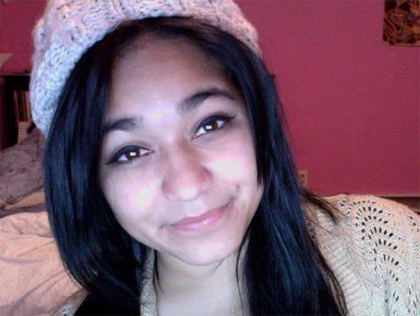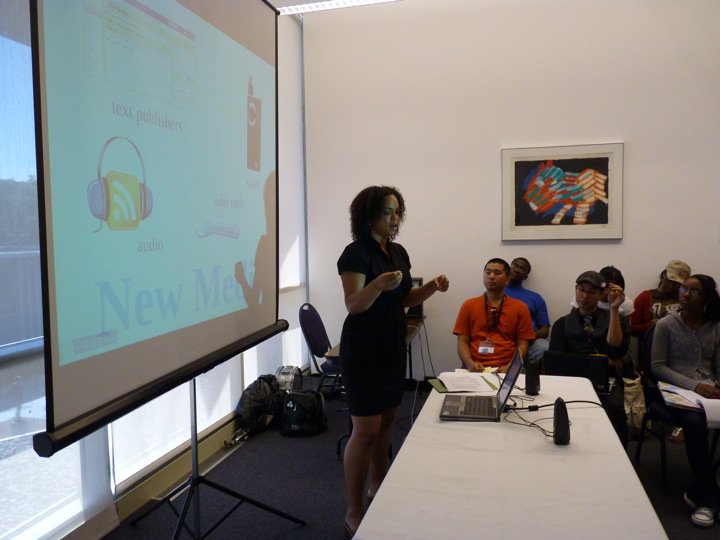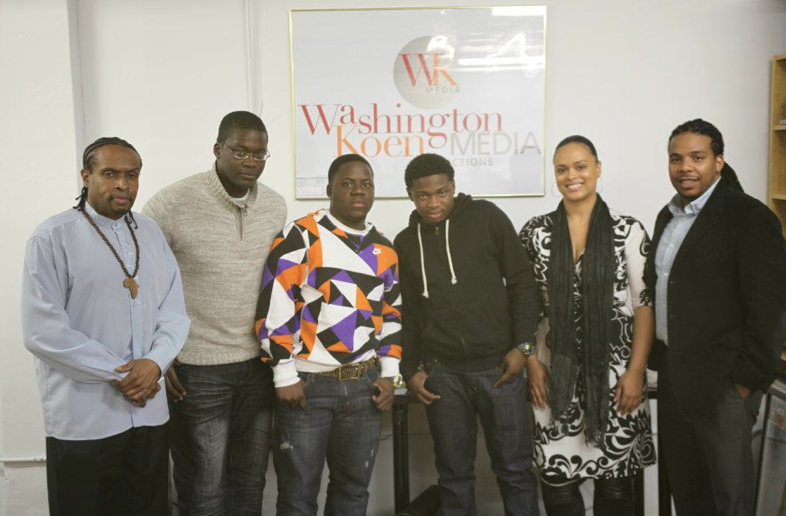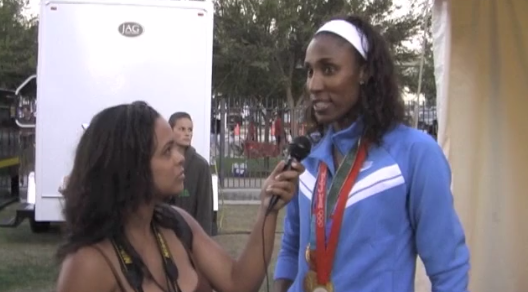Advice for 2014 Media Ideation Fellows
Great news for aspiring social and tech entrepreneurs! Media Ideation is looking for a brand new batch of fellows. Applications are officially open. I had the pleasure of being part of the inaugural class of Media Ideation fellows last year.
Several people have reached out asking for advice as they prepare their applications due January 31, 2014. I've compiled a Q&A list below based on questions people have been asking me. Feel free to tweet me @taralconley if you have additional questions or insights to provide. I'll be sure to update this post with new questions as they come in.
Best of luck to all the applicants!
Can you tell me about your experience with the fellowship?
Overall, my experience with the fellowship has been a good one. I was awarded the graduate level fellowship ($12,000), which afforded me the opportunity to develop TXT CONNECT over the course of 3 months. I’ve met people in the design and tech fields that I probably would not have met otherwise. Certainly there are moments when I wish I had more time and more funds to work with but I think these limitations force you to hone your idea into something that is realistic and feasible. The financial support from the fellowship enabled me to work closely with co-designers (youth in NYC), and as a result I was able to develop a mobile platform with young people and also write a research study based on our time spent together. My research study is currently under the review of an international journal.
How are you using the fellowship for 3 months for a project that will likely take much more time to develop?
As mentioned above, because you have a limited amount of time and funds to work with, the best advice I can give to those who are now applying is to narrow your focus and scope down to an idea that can be developed realistically and feasibly. Ask yourself: What can I realistically accomplish in three or six months? Remember that the fellowship is there to help you develop your idea, so use that time wisely. As visionaries we tend to think long-term, certainly keep this strategy in mind, but also incorporate short-term strategies as a way to scaffold, or build up through each phase.
Think about how best your time and funds can be utilized across various stages of development including technology and legal costs and building relationships over time. Really breakdown what development means for your project. It’s not just the technology itself that has to be developed, but also the relationships and partnerships with stakeholders, community members, and/or end users that also need to be developed and nurtured overtime. As it concerns legal issues and costs, you want to do some research about incorporation and/or terms of service. The fellowship offers access to legal consultants.
How did you choose your deliverables for the fellowship period?
Since TXT CONNECT was also my pilot study for my doctoral research, I already had a good idea of what my timeline looked like going into the fellowship. My deliverables were primarily based on a timeline I created early on. The fellowship asks you to outline a timeline, which I think is a great strategy to get you thinking about what and how you can accomplish various benchmarks and milestones. I knew I had 90 days to work with, so I thought strategically about what I could realistically accomplish each month, whether it was solidifying a name, organizing focus groups, or launching a beta version of the platform, each stage or phase was outlined before I began the fellowship. As you are going through the application process consider this the beginning stage of building your strategy.
What did you do during your fellowship?
I spent most of the fellowship designing and developing TXT CONNECT with co-designers in informal focus group settings. We met once or twice a week for 3 months. I also spent a good deal of time consulting with designers, partners, organizers, and lawyers to help think through development and towards implementation. Overall, I spent most of my time listening to other people and redesigning accordingly.
Founder Tara L. Conley Named 2013 Media Ideation Fellow
I'm so pleased to announced that I've been named as one of the 2013 Media Ideation Fellows! I, along with Kristy Tillman, Charles DeTar, and Yongjun Heo are among the very first class of fellows supported by the Media Ideation Fellowship, a Voqal initiative.
Several months ago, I asked for your nomination for the fellowship and many of you came through with support. For that, I thank you. I'm humbled and overwhelmed with gratitude, especially knowing that my work will be supported financially and by way of professional mentorship. Through the generous support of the Media Ideation Fund, I will be able to begin developing a text line for court-involved youth in New York City.
The Text Line for Court-Involved (CI) Youth [official name TBD] will provide anonymous means for young people who are tethered to foster care, juvenile justice, and criminal justice systems in New York City to access resources and seek support beyond the institutions to which they are bound.
Eventually, users of the text line will be able to:
- Access available tutoring services and job listings in their neighborhoods.
- Access family planning and mental health services.
- Connect immediately to crisis and emergency response hotlines.
- Set up reminders for court dates and other appointments.
- Receive automated information about Know Your Rights (ACLU) and tips/suggestions about how to talk to lawyers and caseworkers.
There is a tremendous amount of work ahead and the fellowship marks only the beginning of further development that will need to be completed to ensure that young people involved in foster care and juvenile justice systems receive the support and resources they need and deserve.
So far this month I've been meeting (and hanging out!) with several young people who are serving as youth advisory board members. Their insights, stories, and perspectives will inform the purpose and uses of the line. The youth advisory board members will be making their public debut on MEDIA MAKE CHANGE very soon, so stick around and prepare to be touched and inspired by the work these incredible young people are doing. I can't wait for you to meet them!
I'll continue to keep MMC readers updated on new developments within the next few months. In addition to a beta launch of the text line, we will also be launching an official Facebook group page that will begin connecting agencies, organizations, resources, and CI youth online and via social media.
Finally, I invite those who will be in the NYC area on March 29th, 2013 to come support me as I audition for TEDxTeachersCollege. I'll be giving a brief pitch on a proposed TED talk about participatory design and how mobile technology can enable members of transient and displaced groups to build stronger connections and networked communities across contexts. It'll be like American Idol for nerds! You can register for the conference by going to TEDxTeachersCollege.com
With that, I leave you with an excerpt about critical connections that has stayed with me since I began this work. The quote comes from Margaret Wheatley.
Rather than worry about critical mass, our work is to foster critical connections. We don't need to convince large numbers of people to change; instead, we need to connect with kindred spirits. Through these relationships, we will develop the new knowledge, practices, courage, and commitment that lead to broad-based change (2006).
If you are a mobile strategist, funder, or developer and interested in learning more about the text line, please email me directly at tara [at] mediamakechange [dot] org.
To Live and Die in Social Media: What We Can Learn From Amanda Todd and Felicia Garcia
On September 7, 2012, Vancouver teen Amanda Todd posted an 8-minute black and white YouTube video, "My story: Struggling, bullying, suicide, self harm" chronicling her struggles with being teased and harassed by fellow classmates. Todd doesn't speak at all throughout the video, and instead holds up placards in front of a webcam. Each piece of paper outlines her story while viewers are provided with a glimpse into Todd's experiences as a victim of cyberbullying, and as according to Naomi Wolf, a victim of adult male cyberstalking. Others have noted that Todd was also victim of slut shaming, or the idea of "shaming and/or attacking a woman or a girl for being sexual, having one or more sexual partners, acknowledging sexual feelings, and/or acting on sexual feelings" (Finally Feminism).

When describing an altercation she had with her classmates at school, Todd writes, "After I got home all I saw was on Facebook - 'She deserved it. Did you wash the mud out of your hair? - I hope she's dead.'"
On October 10, 2012, approximately one month after Todd posted the video on YouTube, she was found dead after an apparent suicide attempt.
On October 24, nearly two weeks after Amanda Todd reportedly committed suicide, Felicia Garcia, a Staten Island teenager jumped in front of a moving train in New York City. Friends and family said Garcia was bullied in school and online because rumors were spreading that she'd been sexually active with football players at her high school. The last words a friend heard Garcia speak right before falling backwards in the path of a moving train were, "Finally, it's here."
Though Garcia's classmates didn't seem to think she was in trouble, a quick glance at Garcia's Instagram pictures tells another story.
Similarly to Todd posting on YouTube, Garcia posted, what I believe to be her last cry for help via Twitter twelve days before she decided to take her own life.
It's heartbreaking to watch our young people take their lives as a result of being bullied by other teens and adults online. As a researcher, I wonder why our young people, girls and boys, decide to use social media as one of the last forms of communication before killing themselves. While it seems like a classic case of cry-for-help, social media further complicates this psychoanalytic narrative by the so-called spectacle in the form of retweets, @ replies, favorites, and likes.
I have to wonder what Amanda and Felicia felt while uploading and posting. What did they really wish to communicate? And has social media now become an alternative to the handwritten suicide letter?
I recently spoke with The Media Bytes about young people in the digital age. I mentioned Amanda Todd in our conversation, in that I believe we failed this young girl in many ways. We had access to knowing and seeing her struggles in a mediated and visible space, yet still we were unable to, or not willing to intervene. During the interview I mentioned that perhaps seeking out social and public spaces while struggling essentially comes down to our basic human need to connect with someone; anyone who will watch our videos and read our tweets.
I understand this need to connect all too well as I also struggled, and was diagnosed with severe depression and post traumatic stress disorder (PTSD) after my father passed away in 2008. I took to singing on Youtube early on while my father was sick. It was a cathartic response to coping with death and dying. It still is. I'm sure if I revisit my Twitter streams, Facebook updates, blog posts, and even SMS text messages during that time immediately after my father's death, I would see myself in my most rawest and vulnerable form. There was something about singing and talking to a camera, then uploading to a public site that allowed me to let go. To where and to whom I let go in this public space was, and is always a risk. But for Amanda and Felicia it was more than simply letting go publicly online, it was a permanent disconnection from a space so-called the 'real' offline world.
Now we are left with YouTube videos, tweets, and Instagram photos that will continue to remind us of our failure as a tribe in the global village.
That said, however, ubiquitous use and mainstream presence of social and mobile media provide a unique opportunity for adults (and anyone else who cares about the well being of young people) to better address youth in crisis. I recognize that the idea of 'crisis' itself carries with it a ton of baggage; what exactly is meant by crisis? Is crisis a word we only use for certain 'kinds' of communities? Is the very idea of wanting to un-do crisis problematic because it automatically assumes something needs to be fixed? And might that 'something' be the child? One look at the comment's section of this post, and the constant victim blaming that ensues, reminds me that we, as a collective, still haven't fully grasped what it means to be empathetic in a crisis situation. So, I recognize the conundrums.
But I also recognize that something unlike anything I've ever witnessed before is happening with our young people in this digital moment. We live in a hypermediated and interconnected world, so much so that we now craft our identities in these public and mediated spaces like corporations do; as brands. We've always created elaborate narratives of ourselves, but now it seems as though these narratives are beginning to take on a posthumous life of their own.
It's fascinating when you think about the posthumous digital life. Yet, I still wonder where do we stand in the midst of this crisis as our young people both live and die in social media?
We simply can't be satisfied with mourning the deaths of these young girls after the fact and behind our computer screens. What keeps us from nurturing our young people while they are alive? What keeps us from engaging them as they explore their multiple and contradictory identities? What keeps us from being more attentive as they express themsevles in these public places---not as a way to police or to monitor inappropriate behaviors---but as a way to gain insight into what's actually happening in their media-rich, public, and interconnected worlds?
Part of what I wish to do as an academic and social entrepreneur is to create spaces where young people like Amanda Todd and Felicia Garcia (who was in foster care) can go to retreat, reconnect, and rebuild. And I believe media and technology can play a transformative role in mediating what I'm calling nurture-networks. But we have to be deliberate and thoughtful in how we further encourage media and technology in the lives of young people, particularly those in crisis.
I recently applied for the Media Ideation Fellowship and my idea is to specifically address the needs and concerns of young people in crisis, namely court-involved youth who are tethered to multiple social institutions like foster care, juvenile, and welfare systems. I'm hoping to create a localized SMS Texline co-developed by and serving the needs of court-inolved youth in New York City. While I understand that media and technology is not *the* answer to address ongoing and dynamic problems young people face in today's world, I do believe that media and tech tools can help to support deliberate efforts in (re)building what's seemingly been broken. As evident with Amanda Todd and Felecia Garcia, our young people are living and dying in these social and mediated spaces, isn't it about time we meet them where they already are?
**Update***
I just discovered that Amanda Todd sang too.
Nominate Tara L. Conley for 2012 Media Ideation Fellowship
Dear family and friends,
I’m writing to you directly for your support in nominating me for the 2012 Media Ideation Fellow (Graduate Level).
The Media Ideation FellowshipSM is an investment in a new generation of social entrepreneurs. Fellows will receive financial resources and mentoring to help bring an early stage idea to life. The Media Ideation FellowshipSM is an opportunity for young innovators to test assumptions, research target audiences, and build strong business plans.
The Media Ideation FellowshipSM is designed to further progressive, social justice-oriented causes. Ideal applicants will have a specific issue or challenge they are looking to address over the course of their fellowship. Projects can be broad in scope, or a simple tool that will help resolve a social inequity or lead to progressive social change.
Why Media Ideation Fellow?
As a Media Ideation Fellow, I will receive a three-month fellowship with a $12,000 stipend and support from mentors in the fields of media and technology.
As some of you may know, since 2010, I’ve dedicated my time and energy to build MEDIA MAKE CHANGE’s brand as best as only one woman could while living in a shoebox apartment located in Harlem, New York. I'm happy to report that as of this summer, MEDIA MAKE CHANGE is officially an LLC in the State of New York. I now seek additional mentorship and financial support to expand MEDIA MAKE CHANGE into the world’s leading incubator for media and technology innovation, ideas, and perspectives for social good.
Specifically, I want to extend MMC's online and mobile platform by building an interactive Call-to-Action Challenge portal (CTAC) that will enable mediamakers, programmers, and designers to submit original ideas and projects that can transform communities and civic engagement practices.
Think: Tech Challenge meets Media That Matters meets Kickstarter.
MEDIA MAKE CHANGE will issue various challenges and calls to action throughout the year so that innovators will have the opportunity to submit their ideas and projects via the CTAC portal, where the public can also make monetary donations.
Challenge prompts might look like the following:
- Submit an idea to create a web or mobile platform that will help voters in your neighborhood locate voting polls on election night.
- Submit an idea to create a web or mobile platform that can help organize constituants to support or protest against a policy-based issue.
- Submit an idea to create an animated short that will inform people about proper recycling practices in your community.
- Submit an idea to create a web series that will explore the lives of women and girl gamers.
- Submit an idea to create a web or mobile platform that will monitor street harassment and bullying in your neighborhood.
- Submit an idea for a digital documentary that explores an issue or perspecitve in the LGBTIQ community.
- Submit an idea for a robot that can assist elderly individuals with daily tasks.
- Submit an idea for a mobile or web platform that can help victims and survivors of environmental catastrophes locate family members, pets, and/or food supplies.
- Submit an idea to create a web or mobile platform that can aid victims of domestic violence and sexual assault.
- Submit an idea to create a digital documentary that explores colorism across various racial and ethnic communities.
The list goes on.
Innovators can set their own funding goals, and successfully funded projects will receive all donations (minus fees).
Unlike established crowdfunding platforms on the web, MEDIA MAKE CHANGE will create specific challenges for media and tech innovators to explore and submit their ideas to. Don't expect to see projects that will fund tech start-ups or music albums. Instead, MMC's CTAC portal is specific in its challenge prompts, content, and design. Only media platforms, projects, and tech gadgets/apps will apply.
My Herstory
I've spent the last 10 years of my life working and playing as a writer, educator, and mediamaker. Over the past decade, I've had the opportunity to work with well established progressive organizations, and learned a great deal about the power of digital media (in all forms) and technology to support causes and promote democracy.
Currently, as a doctoral student studying technology in education, I'm now learning about the importance of computer programming technologies in shaping an entire generation of girls, youth of color, and immigrant learners.
I'm proud to have founded a company that highlights issues relating to media education and technology innovation in efforts to help support communities, confront social injustices, and impact technology policy.
Over the past two years, MEDIA MAKE CHANGE has already established a proven track record in multimedia development by helping to produce the Beyond the Bricks media literacy curriculum and create new media and digital video campaigns for the Schott Foundation for Public Education.
MMC’s blog Media Speaks! has featured original, insightful, and critical content in the area of media literacy, advocacy, and technology innovation.
In the summer of 2012, MEDIA MAKE CHANGE facilitated an online cross-cultural dialogue with In Conversation, a monthly feature that highlighted women of color programmers and mediamakers. Additionally, MMC led a nationwide social media and digital storytelling campaign with #RememberKatrina to bring awareness to environmental and social issues facing citizens living in Louisiana and surrounding states. MMC is also currently working with social entrepreneurs to produce successful crowdfunding campaigns.
Looking ahead, I want to solidify MEDIA MAKE CHANGE’s place in digita media and social justice history by incorporating a dynamic interactive platform that will inspire people to use media and technology to change their communities for the better.
As a Media Ideation Fellow, I will be able to take change agency to the masses with the help of mentorship and financial assistance.
With the support of the Media Ideation Fellowship, I will be able to:
- research established crowdfuding, educational technology, media education, and progressive online platforms
- develop proposals and business plans for potential investors
- gather a team of official MEDIA MAKE CHANGE mediamakers and content producers
- design and develop MMC’s interactive Call-to-Action Challenge (CTAC) portal
The fellowship will afford me the time to conduct research and produce work that will reflect an expansion of MEDIA MAKE CHANGE's brand and mission towards interactivity and civic/community engagement.
In order to accomplish this and more, I’m asking for your nomination for the 2012 inaugural Media Ideation Fellowship.
How to nominate me
You can support by simply going to http://mediaideation.org/nominate/ and filling out the information provided below:
- My name: Tara Conley
- My email: tara@mediamakechange.org
- Check the box for “Graduate Level” fellowship.
I sincerely appreciate your love and support.
Tara














